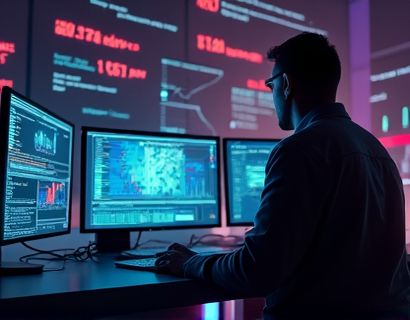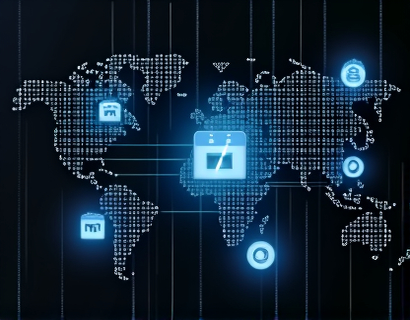Blockchain-Powered Asset Tokenization: Bridging Physical Assets with Digital Liquidity for Enhanced Market Accessibility
Blockchain technology is at the forefront of transforming traditional asset management by introducing a novel method for tokenizing real-world assets. This innovative approach not only enhances liquidity but also broadens market accessibility, creating a more transparent and efficient ecosystem for asset holders and investors. By integrating physical assets into the digital realm, blockchain offers a secure and trustworthy environment that streamlines transactions and expands market reach.
The concept of asset tokenization involves representing physical assets, such as real estate, art, and infrastructure, as digital tokens on a blockchain. These tokens are unique digital representations that mirror the properties and value of the underlying asset. The process begins with the identification and valuation of the asset, followed by the creation of a smart contract that defines the rules and conditions for the token's issuance, trading, and management.
One of the primary benefits of blockchain-powered asset tokenization is the enhancement of liquidity. Traditional assets are often illiquid due to their physical nature and the cumbersome processes involved in buying, selling, and transferring ownership. Tokenization removes these barriers by allowing assets to be divided into smaller, tradable units, much like stocks or cryptocurrencies. This divisibility makes it easier for investors to enter and exit positions, thereby increasing market participation and liquidity.
For instance, consider a commercial real estate property. Traditionally, selling a portion of the property would involve complex legal processes and significant transaction costs. With tokenization, the property can be divided into digital tokens, each representing a fraction of the property's value. These tokens can then be bought and sold on digital platforms, providing investors with the flexibility to trade smaller amounts and exit investments more easily.
Enhanced liquidity is not the only advantage. Blockchain tokenization also improves market accessibility. Smaller investors who previously lacked the capital to enter certain markets can now participate by purchasing tokenized fractions of high-value assets. This democratization of access fosters a more inclusive financial ecosystem, where a broader range of participants can benefit from investment opportunities.
The integration of physical assets into the blockchain also brings unprecedented transparency. Every transaction involving tokenized assets is recorded on the blockchain, creating an immutable and verifiable ledger. This transparency reduces the risk of fraud and errors, as all parties can independently verify the asset's history and current ownership. Moreover, the smart contracts that govern token operations automatically enforce the agreed-upon terms, eliminating the need for intermediaries and reducing transaction costs.
Another significant benefit is the increased efficiency in asset management. Blockchain technology automates many of the manual processes involved in asset trading and management, such as due diligence, settlement, and compliance. Smart contracts can be programmed to execute these tasks based on predefined conditions, ensuring that transactions are completed swiftly and accurately. This automation not only saves time but also reduces the potential for human error, enhancing the overall reliability of the asset management process.
Furthermore, tokenized assets can be easily integrated into existing financial systems and platforms. Digital tokens can be traded on cryptocurrency exchanges, held in digital wallets, and used as collateral for loans. This interoperability allows asset holders to leverage their investments across various financial instruments and services, maximizing the utility and value of their assets.
The potential applications of blockchain-powered asset tokenization extend beyond traditional real estate and art. Infrastructure projects, such as bridges, roads, and utilities, can be tokenized to attract investment and manage funding more effectively. For example, a bridge construction project can issue tokens representing shares in the project. Investors can purchase these tokens to support the project and receive returns based on the bridge's usage and revenue generation.
In the realm of supply chain management, tokenization can enhance traceability and efficiency. By tokenizing physical goods, each stage of the supply chain can be recorded on the blockchain, providing a transparent and tamper-proof record of the product's journey from production to consumption. This not only improves inventory management but also helps in verifying the authenticity and origin of products, which is particularly crucial for industries like pharmaceuticals and luxury goods.
The environmental impact of asset tokenization should also be considered. Traditional asset transactions often involve paper-based processes and physical movements, contributing to carbon emissions. Digital tokenization reduces the need for physical documents and transportation, thereby lowering the environmental footprint of asset management. This aligns with the growing global emphasis on sustainability and responsible investing.
Despite its numerous advantages, blockchain-powered asset tokenization faces several challenges. Regulatory uncertainty remains a significant hurdle, as financial authorities worldwide are still grappling with how to classify and regulate tokenized assets. Clear and consistent regulations are essential to ensure market stability and investor protection. Additionally, scalability issues with current blockchain technologies need to be addressed to handle the high volume of transactions required for widespread asset tokenization.
Technical complexity is another barrier, as the adoption of blockchain and tokenization requires a certain level of technical expertise. Educational initiatives and user-friendly platforms are necessary to bridge the knowledge gap and make these technologies accessible to a broader audience. Security concerns, while generally mitigated by the inherent properties of blockchain, still require ongoing vigilance and robust security measures to protect against potential threats.
To overcome these challenges, industry stakeholders must collaborate to develop standardized frameworks and best practices. Regulators, technologists, and asset managers need to work together to create a conducive environment for the growth of blockchain-powered asset tokenization. By fostering innovation while ensuring regulatory compliance and security, the potential of this technology can be fully realized.
In conclusion, blockchain-powered asset tokenization represents a transformative shift in how physical assets are managed and traded. By enhancing liquidity, improving market accessibility, and increasing transparency and efficiency, this technology opens up new opportunities for asset holders and investors. As the ecosystem continues to evolve, addressing regulatory and technical challenges will be crucial for widespread adoption. The future of asset management is digital, and blockchain is leading the way.










































